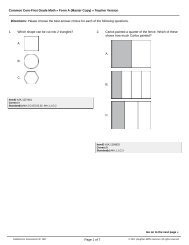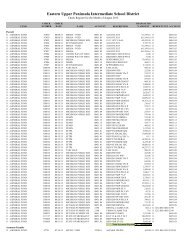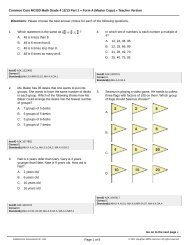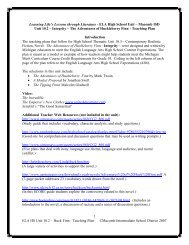Teaching Algebra with Manipulatives
Teaching Algebra with Manipulatives
Teaching Algebra with Manipulatives
Create successful ePaper yourself
Turn your PDF publications into a flip-book with our unique Google optimized e-Paper software.
Chapter 8 <strong>Teaching</strong> Notes and Overview<br />
As a preview to Lesson 8-7, have students<br />
form groups of two or three to complete this<br />
recording sheet using algebra tiles. There are<br />
three activities used as examples. Discuss each<br />
activity, and then have the students use the<br />
algebra tiles to model it along <strong>with</strong> you. The<br />
three activities are to use tiles to find:<br />
(x 2)(x 5); (x 1)(x 4); and (x 3)(2x 1).<br />
In their groups, have students complete<br />
Exercises 1–3. Then go over their answers. Let<br />
them do Exercises 4–11 on their own. As soon<br />
as the groups are finished, discuss the answers.<br />
Answers<br />
See Teacher Wraparound Edition pp. 450–451.<br />
Using Overhead<br />
<strong>Manipulatives</strong><br />
Multiplying Polynomials<br />
(pp. 145–146 of this booklet)<br />
Use With Lesson 8-7.<br />
Objective Model and find the product of two<br />
binomials.<br />
Materials<br />
algebra tiles*<br />
product mat transparency*<br />
transparency pen*<br />
blank transparency<br />
* available in Overhead Manipulative Resources<br />
This demonstration contains two activities and<br />
an extension.<br />
• Demonstration 1 involves finding the product<br />
of two binomials, namely, (x 1)(x 4) using<br />
algebra tiles.<br />
• Demonstration 2 involves finding the product<br />
of two binomials, namely, (x 2)(2x 3)<br />
using algebra tiles.<br />
• The Extension deals <strong>with</strong> comparing the use<br />
of algebra tiles to find a product <strong>with</strong> the<br />
FOIL method.<br />
Answers<br />
Answers appear on the teacher demonstration<br />
instructions on pages 145–146.<br />
<strong>Algebra</strong> Activity<br />
Multiplying Polynomials<br />
(pp. 147–148 of this booklet)<br />
Use With Lesson 8-7.<br />
Objective Multiply polynomials by using the<br />
Distributive Property.<br />
Materials<br />
classroom set of <strong>Algebra</strong> Activity worksheets<br />
transparency master of <strong>Algebra</strong> Activity<br />
Before class, cut the figures on the transparency<br />
that are below the dashed line and color them if<br />
you wish. You may want to make similar sets of<br />
squares and rectangles for students from heavy<br />
paper.<br />
Discuss how to find the area of figures A–D on<br />
the transparency. Students need to know that<br />
the area of a rectangle is the product of its<br />
length and width.<br />
A Area (6)(6)<br />
B Area (6)(4) (6)(2)<br />
C Area (6)(6) (6)(2)<br />
D Area (3)(4) (3)(2) (3)(4) (3)(2)<br />
Be sure students understand that this is an<br />
application of the Distributive Property.<br />
Have students complete Exercises 1–3 on the<br />
worksheet.<br />
Assign area values to the models: x-by-x x 2 ,<br />
1-by-x x and 1-by-1 1. Place the models<br />
over matching spaces of figures E–H on the<br />
transparency. Discuss finding the products by<br />
adding the areas.<br />
E Area x(x 1) x 2 x<br />
F Area x(x 3) x 2 3x<br />
G Area x(x 2) x 2 2x<br />
H Area (x 1)(x 4) x 2 5x 4<br />
In groups, have students use diagrams or<br />
models to complete the worksheet.<br />
As an extension, challenge students to factor<br />
polynomials by creating a rectangle and<br />
working backwards.<br />
© Glencoe/McGraw-Hill 132 <strong>Teaching</strong> <strong>Algebra</strong> <strong>with</strong> <strong>Manipulatives</strong>







